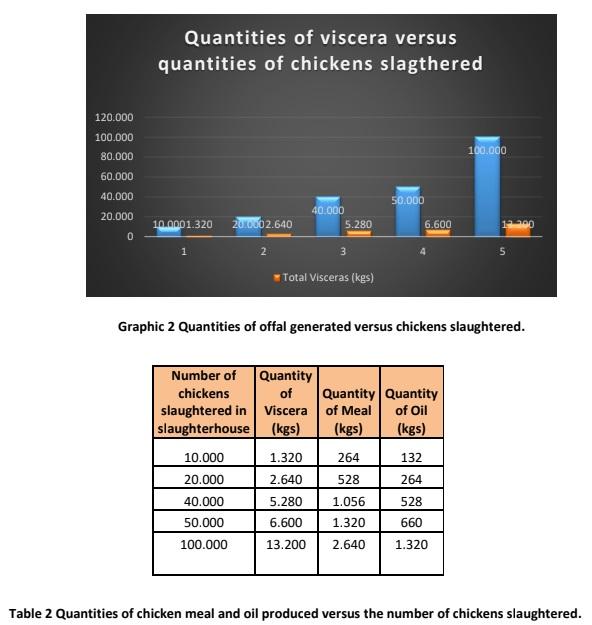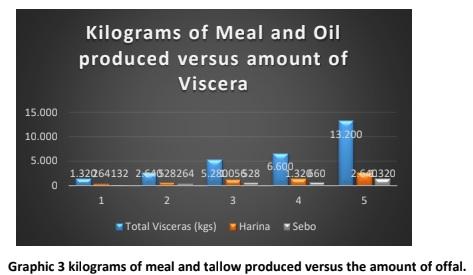Rendering Plants: Poultry Meal
Published: August 11, 2023
By: Ing. Wilki Ramón Santander Ovalles / Technical consultant Meat Rendering Plants.

1. Raw Material
1.1 The main raw material to obtain Poultry Meal is mainly chicken viscera, to which other by-products such as chicken carcass can be added in small quantities to improve consistency, especially during pressing process downstream. Table 1 indicates how many by-products are generated depending on the number of chickens slaughtered in the slaughterhouse, the table also indicates the amounts of viscera and feathers that are generated depending on the number of chickens slaughtered. In this case, the frequency is daily. The viscera are transported to the Rendering Plant by means like pneumatic transport or with water to a sieve to separate excess water if the plant is integrated with the slaughterhouse, later it is sent to a hopper by screw conveyor, or transported by trucks if the viscera comes from slaughterhouses outside the plant, the hopper is recommended with a capacity of up to 7 hours of production because this is the maximum time where the viscera have already decomposed to a level that generates many inconveniences downstream. Chicken viscera have a yield between 20-25% flour and 10-12% chicken oil.



2. Cooking of the viscera
2.1 The process of cooking the viscera (using the dry method where heating is with indirect steam) can be done using a batch cooker or a continuous cooker.
2.2 When cooking is done in a batch cooker there are two decision variables to control the process: temperature and cooking time. This procedure is recommended when small amounts of raw material are processed, since there are no major drawbacks as long as the reception hopper has a good water drainage system and that no Project manager thinks of inventing (undersizing) the extraction system. of gases either by natural draft or induced to save money in the assembly. (Here a process of 2 or 3 hours becomes 8 hours). The average temperature is around 135 degrees Celsius and the cooking time is between 2 and 3 hours.
2.3 If the process of cooking the viscera is carried out in a continuous cooker, there are 4 decision variables: Internal pressure, Final cooking temperature, Cooker load level and Fat level inside the cooker (chicken oil). This procedure is recommended for large amounts of viscera, here the ideal is for the operators to be well trained with the interrelation of the 4 variables to obtain the maximum performance of the equipment. Not understanding this interrelationship well can cause huge inconveniences in the process and the quality of the products obtained. The final cooking temperature is between 125 and 140 degrees depending on the residence time of the material inside the continuous cooker. The charge level between 60 and 70%, the internal pressure between 0 and -10 in h20 (ideal) and the grease (oil) level between 1⁄4 and 1⁄2 of the level indicator.
3. Pressing
In the offal meal, this process is key since the offal and percolate cake that goes to the presses has a much lower compressibility than other meals of animal origin. That is why some plants mix the viscera with a little carapace (carcass) to increase the compressibility of the viscera cake. It should be noted that the viscera cake is the most docile material with the turns (flights) of the worm (worm screw) since they do not suffer as much wear as when meat and bone meal cakes are processed. Here the amperage of the motor is the most important monitoring parameter since it indicates the effort that the motor of the press makes against the material, this is what some call the press point, which is nothing more than the point where the material generates the back pressure. optimal for the oil to separate from the cake and flow towards the oil reception drawer, obtaining an offal cake with a fat percentage below 10%. In hydraulic shock presses, the operator manages the pressure generated by the hydraulic system as an operating variable to achieve the proper pressure inside the cage.
4. Meal Grinding
If the pressing of the viscera cake has been optimal and the cake comes with an adequate percentage of fat around 10%, the grinding will not have a problem, if the percentage of fat is very high around 15 -18% lid the holes in the mill, causing stops to clean the mesh and increasing the current consumption of the motor.
5. Centrifuge
During the cleaning of the oil in the centrifuge, the most important parameters are the temperature that the oil reaches the centrifuge, the higher it is without damaging the quality of the oil, a better separation will be obtained, since the viscosity decreases and the centrifuge increases its efficiency and the second the difference in speeds of the rotor and the external drum.
6. Storage Tanks and screw conveyors
6.1 The bulb density of the viscera meal of 600 kg/m3 can be calculated with this data, the volumes necessary to design the storage tanks and the capacity to transfer the viscera meal via augers.
7. Conclusions
Very well-processed viscera meal with the parameters required by pet companies is priced very well, around $0.3/kg above normal viscera meal, which already has a price of 0.1- $0.2/kg above a meat and bone meal. If I process 10 MT of viscera per day, it is 220 MT per month, 2,640 MT of processed viscera per year, with which 528 MT of viscera meal are obtained, which represents a difference of $158,400 between petfood viscera meal and normal viscera meal. Of course, this operation entails adjustments and costs that normal offal meal does not have, but I assure you that the difference is not very far from this amount. Do the exercise for 20 TM, 30 TM and 50 TM per day. The downside for me is that chicken entrails are the most treacherous material of all animal-derived meals, and it is where I have observed the most serious problems in a throughput plant, from deaths from H2S buildup to near bankruptcy of a company for flaws in the gas extraction design due to an error in understanding the difference between processing meat and bone meal and chicken offal meal. According to projections, the market that will grow the most is the consumption of chicken meat, for example, Mexico where the consumption of chicken meat grew by 19% between 2020 and 2021, as a consequence this means more chicken viscera and feathers that must be processed.
Related topics:
Authors:
Recommend
Comment
Share

Would you like to discuss another topic? Create a new post to engage with experts in the community.






.jpg&w=3840&q=75)